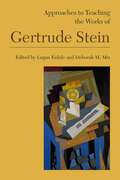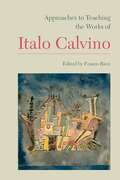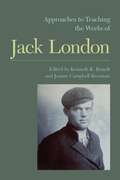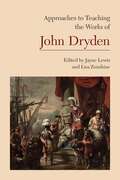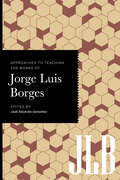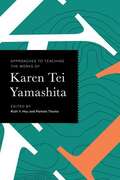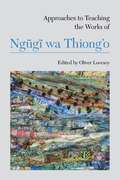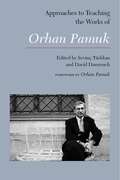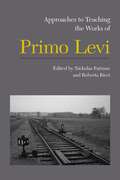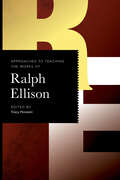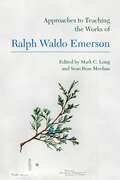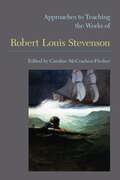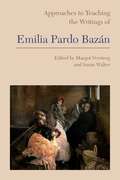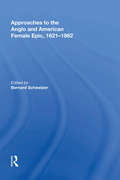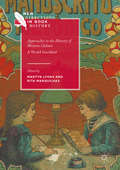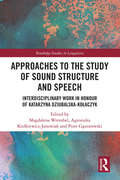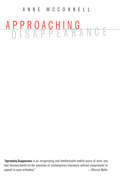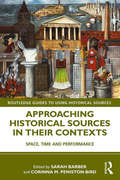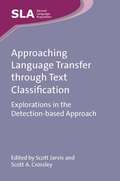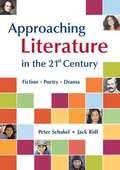- Table View
- List View
Approaches to Teaching the Works of Gertrude Stein (Approaches to Teaching World Literature #152)
by Logan Esdale and Deborah M. MixA trailblazing modernist, Gertrude Stein studied psychology at Radcliffe with William James and went on to train as a medical doctor before coming out as a lesbian and moving to Paris, where she collected contemporary art and wrote poetry, novels, and libretti. Known as a writer's writer, she has influenced every generation of American writers since her death in 1946 and remains avant-garde.Part 1 of this volume, "Materials," provides information and resources that will help teachers and students begin and pursue their study of Stein. The essays of part 2, "Approaches," introduce major topics to be covered in the classroom--race, gender, feminism, sexuality, narrative form, identity, and Stein's experimentation with genre--in a wide range of contexts, including literary analysis, art history, first-year composition, and cultural studies.
Approaches to Teaching the Works of Inca Garcilaso de la Vega (Approaches to Teaching World Literature #169)
by Christian Fernández and José Antonio MazzottiThe author of Comentarios reales and La Florida del Inca, now recognized as key foundational works of Latin American literature and historiography, Inca Garcilaso de la Vega was born in 1539 in Cuzco, the son of a Spanish conquistador and an Incan princess, and later moved to Spain. Recalling the family stories and myths he had heard from his Quechua-speaking relatives during his youth and gathering information from friends who had remained in Peru, he created works that have come to indelibly shape our understanding of Incan history and administration. He also articulated a new American identity, which he called mestizo.This volume provides guidance on the translations of Garcilaso's writings and on the scholarly reception of his ideas. Instructors will discover ideas for teaching Garcilaso's works in relation to indigenous thought, European historiography, natural history, indigenous religion and Christianity, and Incan material culture. In essays informed by postcolonial and decolonial perspectives, scholars draw connections between Garcilaso's writings and contemporary issues like migration, multiculturalism, and indigenous rights.
Approaches to Teaching the Works of Italo Calvino (Approaches to Teaching World Literature #125)
by The Modern Language Association of AmericaItalo Calvino, whose works reflect the major literary and cultural trends of the second half of the twentieth century, is known for his imagination, humor, and technical virtuosity. He explores topics such as neorealism, folktale, fantasy, and social and political allegory and experiments with narrative style and structure. Students take delight in Calvino's wide-ranging and inventive work, whether in Italian courses or in courses in comparative or world literature, literary criticism, cultural studies, philosophy, or even architecture.Given the range of his writing, teaching Calvino can seem a daunting task. This volume aims to help instructors develop creative and engaging classroom strategies. Part 1, "Materials," presents an overview of Calvino's writings, nearly all of which are available in English translation, as well as critical works and online resources. The essays in part 2, "Approaches," focus on general themes and cultural contexts, address theoretical issues, and provide practical classroom applications. Contributors describe strategies for teaching Calvino that are as varied as his writings, whether having students study narrative theory through If on a winter's night a traveler, explore literary genre with Cosmicomics, improve their writing using Six Memos for the Next Millennium, or read Mr. Palomar in a general education humanities course.
Approaches to Teaching the Works of Jack London (Approaches to Teaching World Literature #132)
by Jeanne Campbell ReesmanA prolific and enduringly popular author--and an icon of American fiction--Jack London is a rewarding choice for inclusion in classrooms from middle school to graduate programs. London's biography and the role played by celebrity have garnered considerable attention, but the breadth of his personal experiences and political views and the many historical and cultural contexts that shaped his work are key to gaining a nuanced view of London's corpus of works, as this volume's wide-ranging perspectives and examples attest.The first section of this volume, "Materials," surveys the many resources available for teaching London, including editions of his works, sources for his photography, and audiovisual aids. In part 2, "Approaches," contributors recommend practices for teaching London's works through the lenses of socialism and class, race, gender, ecocriticism and animal studies, theories of evolution, legal theory, and regional history, both in frequently taught texts such as The Call of the Wild, "To Build a Fire," and Martin Eden and in his lesser-known works.
Approaches to Teaching the Works of John Dryden (Approaches to Teaching World Literature #126)
by The Modern Language AssociationWhich John Dryden should be brought into the twenty-first-century college classroom? The rehabilitator of the ancients? The first of the moderns? The ambivalent laureate? The sidelined convert to Rome? The literary theorist? The translator? The playwright? The poet? This volume in the MLA series Approaches to Teaching World Literature addresses the tensions, contradictions, and versatility of a writer who, in the words of Samuel Johnson, "found [English poetry] brick, and left it marble," who was, in the words of Walter Scott, "one of the greatest of our masters."Part 1, "Materials," offers a guide to the teaching editions of Dryden's work and a discussion of the background resources, from biographies and literary criticism to social, cultural, political, and art histories. In part 2, "Approaches," essays describe different pedagogical entries into Dryden and his time. These approaches cover subjects as various as genre, adaptation, literary rivalry, musical setting, and political and religious poetry in classroom situations that range from the traditional survey to learning through performance.
Approaches to Teaching the Works of Jorge Luis Borges (Approaches to Teaching World Literature #180)
by José Eduardo GonzálezOften considered a writer who transcends national borders, Jorge Luis Borges also aimed to reinvent the history and traditions of his own country, Argentina. His unconventional works appeal to students, who nonetheless can find his richly intertextual prose challenging. Addressing courses in Spanish and in English, this volume offers innovative approaches that help students navigate the texts, engage with them emotionally and creatively, and understand the time and place of their production while connecting them to the present.Part 1, "Materials," provides detailed biographical information about Borges as well as print and digital resources. The essays in part 2, "Approaches," offer strategies for discussing his writing process, his manuscripts, and the material history and translation of his texts. Contributors also examine Borges's influences, which include film, mythology, history, and ideas of Islam and Judaism; the author's interest in humor and games; and resonances with other literary works.
Approaches to Teaching the Works of Karen Tei Yamashita (Approaches to Teaching World Literature #168)
by Ruth Y. Hsu and Pamela ThomaStructurally innovative and culturally expansive, the works of Karen Tei Yamashita invite readers to rethink conventional paradigms of genres and national traditions. Her novels, plays, and other texts refashion forms like the immigrant tale, the postmodern novel, magical realism, apocalyptic literature, and the picaresque and suggest new transnational, hemispheric, and global frameworks for interpreting Asian American literature.Addressing courses in American studies, contemporary fiction, environmental humanities, and literary theory, the essays in this volume are written by undergraduate and graduate instructors from across the United States and around the globe. Part 1, "Materials," outlines Yamashita's novels and other texts, key works of criticism and theory, and resources for Asian American and Asian Brazilian literature and culture. Part 2, "Approaches," provides options for exploring Yamashita's works through teaching historical debates, outlining principles of environmental justice, mapping geographic boundaries to highlight power dynamics, and drawing personal connections to the texts. Additionally, an essay by Yamashita describes her own approaches to teaching creative writing.
Approaches to Teaching the Works of Miguel de Unamuno (Approaches to Teaching World Literature #164)
by Luis Álvarez-CastroA central figure of Spanish culture and an author in many genres, Miguel de Unamuno (1864-1936) is less well known outside Spain. He was a surprising writer and thinker: a professor of Greek who embraced metafiction and modernist methods, a proponent of Castilian Spanish although born in the Basque Country and influenced by many international writers, and an early existentialist who was yet religious. He found himself in opposition to both King Alfonso XIII and the military dictatorship of Miguel Primo de Rivera and then became involved in the political upheaval that led to the Spanish Civil War.Part 1 of this volume, "Materials," gives information on different editions and translations of Unamuno's works, on scholarly and critical secondary sources, and on Web resources. The essays in part 2, "Approaches," offer suggestions for introducing students to the range of his works--novels, essays, poetry, and drama--in Spanish language and literature, comparative literature, religion, and philosophy classrooms.
Approaches to Teaching the Works of Ngũgĩ wa Thiong'o (Approaches to Teaching World Literature #121)
by Oliver LoveseyNgũgĩ wa Thiong'o is one of the most important and celebrated authors of postindependence Africa as well as a groundbreaking postcolonial theorist. His work, written first in English, then in Gikuyu, engages with the transformations of his native Kenya after what is often termed the Mau Mau rebellion. It also gives voice to the struggles of all Africans against economic injustice and political oppression. His writing and activism have continued despite imprisonment, the threat of assassination, and exile.Part 1 of this volume, "Materials," provides resources and background for the teaching of Ngũgĩ's novels, plays, memoirs, and criticism. The essays of part 2, "Approaches," consider the influence of Frantz Fanon, Karl Marx, and Joseph Conrad on Ngũgĩ; how the role of women in his fiction is inflected by feminism; his interpretation and political use of African history; his experimentation with orality and allegory in narrative; and the different challenges of teaching Ngũgĩ in classrooms in the United States, Europe, and Africa.
Approaches to Teaching the Works of Orhan Pamuk (Approaches to Teaching World Literature #146)
by Sevinç Türkkan and David DamroschWinner of the Nobel Prize in Literature in 2006, Orhan Pamuk is Turkey's preeminent novelist and an internationally recognized figure of letters. Influenced by both Turkish and European literature, his works interrogate problems of modernity and of East and West in the Turkish context and incorporate the Ottoman legacy linguistically and thematically. The stylistic and thematic aspects of his novels, his intriguing use of intertextual elements, and his characters' metatextual commentaries make his work rewarding in courses on world literature and on the postmodern novel. Pamuk's nonfiction writings extend his themes of memory, loss, personal and political histories, and the craft of the novel.Part 1, "Materials," provides biographical background and introduces instructors to translations and critical scholarship that will elucidate Pamuk's works. In part 2, "Approaches," essays cover topics that support teachers in a range of classrooms, including Pamuk's use of the Turkish language, the political background to Pamuk's novels, the politics of translation and aesthetics, and Pamuk's works as world literature.
Approaches to Teaching the Works of Primo Levi (Approaches to Teaching World Literature #133)
by Nicholas Patruno Roberta RicciPrimo Levi, Holocaust survivor and renowned memoirist, is one of the most widely read writers of post-World War II Italy. His works are characterized by the lean, dispassionate eloquence with which he approaches his experience of incarceration in Auschwitz. His memoirs--as well as his poetry and fiction and his many interviews--are often taught in several fields, including Jewish studies and Holocaust studies, comparative literature, and Italian language and literature, and can enrich the study of history, psychology, and philosophy.The first part of this volume provides instructors with an overview of the available editions, anthologies, and translations of Levi's work and identifies other useful classroom aids, such as films, music, and online resources. In the second part, contributors describe different approaches to teaching Levi's work. Some, in presenting Survival in Auschwitz, The Reawakening, and The Drowned and the Saved, look at the place of style in Holocaust testimony and the reliability of memory in autobiography. Others focus on questions of translation, complicated by the untranslatable in the language and experiences of the concentration camps, or on how Levi incorporates his background as a chemist into his writing, most clearly in The Periodic Table.
Approaches to Teaching the Works of Ralph Ellison (Approaches to Teaching World Literature #177)
by Tracy FloreaniOne of the most important American authors and public intellectuals of the twentieth century, Ralph Ellison had a keen and unsentimental understanding of the relationship between race, art, and activism in American life. He contended with other writers of his day in his examination of the entrenched racism in society, and his writing continues to inform national conversations in letters and culture.The essays in Approaches to Teaching the Works of Ralph Ellison will help instructors in colleges, high schools, and prisons teach not only the indispensable Invisible Man but also Ellison's short stories, his essays, and the two editions of his second, unfinished novel, Juneteenth and Three Days before the Shooting . . . . In considering Ellison's works in relation to jazz, technology, humor, politics, queerness, and disability, this volume mirrors the breadth of Ellison's own life, which extended from the Jim Crow era through the Black Power movement.
Approaches to Teaching the Works of Ralph Waldo Emerson (Approaches to Teaching World Literature #155)
by Mark C. Long and Sean Ross MeehanA leader of the transcendentalist movement and one of the country's first public intellectuals, Ralph Waldo Emerson has been a long-standing presence in American literature courses. Today he is remembered for his essays, but in the nineteenth century he was also known as a poet and orator who engaged with issues such as religion, nature, education, and abolition.This volume presents strategies for placing Emerson in the context of his time, for illuminating his rhetorical techniques, and for tracing his influence into the present day and around the world. Part 1, "Materials," offers guidance for selecting classroom editions and information on Emerson's life, contexts, and reception. Part 2, "Approaches," provides suggestions for teaching Emerson's works in a variety of courses, not only literature but also creative writing, religion, digital humanities, media studies, and environmental studies. The essays in this section address Emerson's most frequently anthologized works, such as Nature and "Self-Reliance," along with other texts including sermons, lectures, journals, and poems.
Approaches to Teaching the Works of Robert Louis Stevenson (Approaches to Teaching World Literature #124)
by Caroline McCracken-FlesherAlthough Robert Louis Stevenson was a late Victorian, his work--especially Treasure Island and The Strange Case of Dr. Jekyll and Mr. Hyde--still circulates energetically and internationally among popular and academic audiences and among young and old. Admired by Henry James, Vladimir Nabokov, and Jorge Luis Borges, Stevenson's fiction crosses the boundaries of genre and challenges narrow definitions of the modern and the postmodern.Part 1 of this volume, "Materials," provides an introduction to the writer's life, a survey of the criticism of his work, and a variety of resources for the instructor. In part 2, "Approaches," thirty essays address such topics as Stevenson's dialogue with James about literature; his verse for children; his Scottish heritage; his wanderlust; his work as gothic fiction, as science fiction, as detective fiction; his critique of imperialism in the South Seas; his usefulness in the creative writing classroom; and how Stevenson encourages expansive thinking across texts, times, places, and lives.
Approaches to Teaching the Writings of Emilia Pardo Bazán (Approaches to Teaching World Literature #147)
by Margot Versteeg Susan Walter"Emilia Pardo Bazán (1851-1921) was the most prolific and influential woman writer of late nineteenth-century Spain," write the editors of this volume in the MLA's Approaches to Teaching World Literature series. Contending with the critical literary, cultural, and social issues of the period, Pardo Bazán's novels, novellas, short stories, essays, plays, travel writing, and cookbooks offer instructors countless opportunities to engage with a variety of critical frameworks. The wide range of topics in the author's works, from fashion to science and technology to gender equality, and the brilliance of her literary style make Pardo Bazán a compelling figure in the classroom.Part 1, "Materials," provides biographical and critical resources, an overview of Pardo Bazán's vast and diverse oeuvre, and a literary-historical time line. It also reviews secondary sources, editions and translations, and digital resources. The twenty-three essays in part 2, "Approaches," explore various issues that are central to teaching Pardo Bazán's works, including the author's engagement with contemporary literary movements, feminism and gender, nation and the late Spanish empire, Spanish and Galician identities, and nineteenth-century scientific and medical discourses. Film adaptations and translations of Pardo Bazán's works are also addressed. Highlighting the artistic, social, and intellectual currents of Pardo Bazán's writings, this volume will assist instructors who wish to teach the author's works in courses on world literature, nineteenth-century literature, and gender studies as well as in Spanish-language courses.
Approaches to the Anglo and American Female Epic, 1621-1982
by Bernard SchweizerEpic has long been regarded as the exclusive domain of the male literary genius and as an incarnation of patriarchal values. This provocative collection of essays challenges such a hegemonic stereotype by demonstrating the ways in which women writers have successfully adapted the masculine epic tradition to suit their own aesthetic needs and to express their own heroic literary, social, and historical visions. Bringing the female epic out of the shadows, the contributors rethink generic boundaries to illuminate this heretofore hidden literary practice. The essays range from Mary Tighe to Rebecca West from Elizabeth Barrett Browning to Gwendolyn Brooks, and from Frances Burney to Virginia Woolf. Bernard Schweizer's introduction, titled 'Muses with Pens,' connects the trajectory of ideas and influences in the individual essays to demonstrate how each participates in reclaiming for women writers a place in the development of a female epic tradition. The volume will be an invaluable resource for scholars working on issues related to genre, canon formation, and the evolution of female literary authority.
Approaches to the Evolution of Language: Language Evolution
by Rudolf BothaHow can we unravel the evolution of language, given that there is no direct evidence about it? Rudolf Botha addresses this intriguing question in his fascinating new book. Inferences can be drawn about language evolution from a range of other phenomena, serving as windows into this prehistoric process. These include shell-beads, fossil skulls and ancestral brains, modern pidgin and creole languages, homesign systems and emergent sign languages, modern motherese, language use of modern hunter-gatherers, first language acquisition, similarities between language and music, and comparative animal behaviour. The first systematic analysis of the Windows Approach, it will be of interest to students and researchers in many disciplines, including anthropology, archaeology, linguistics, palaeontology and primatology, as well as anyone interested in how language evolved.
Approaches to the Evolution of Language: Language in Prehistory
by Alan BarnardFor ninety per cent of our history, humans have lived as 'hunters and gatherers', and for most of this time, as talking individuals. No direct evidence for the origin and evolution of language exists; we do not even know if early humans had language, either spoken or signed. Taking an anthropological perspective, Alan Barnard acknowledges this difficulty and argues that we can nevertheless infer a great deal about our linguistic past from what is around us in the present. Hunter-gatherers still inhabit much of the world, and in sufficient number to enable us to study the ways in which they speak, the many languages they use, and what they use them for. Barnard investigates the lives of hunter-gatherers by understanding them in their own terms, to create a book which will be welcomed by all those interested in the evolution of language.
Approaches to the History of Written Culture: A World Inscribed (New Directions in Book History)
by Martyn Lyons Rita MarquilhasThis book investigates the history of writing as a cultural practice in a variety of contexts and periods. It analyses the rituals and practices determining intimate or 'ordinary' writing as well as bureaucratic and religious writing. From the inscribed images of 'pre-literate' societies, to the democratization of writing in the modern era, access to writing technology and its public and private uses are examined. In ten studies, presented by leading historians of scribal culture from seven countries, the book investigates the uses of writing in non-alphabetical as well as alphabetical script, in societies ranging from Native America and ancient Korea to modern Europe. The authors emphasise the material characteristics of writing, and in so doing they pose questions about the definition of writing itself. Drawing on expertise in various disciplines, they give an up-to-date account of the current state of knowledge in a field at the forefront of 'Book History'.
Approaches to the Study of Sound Structure and Speech: Interdisciplinary Work in Honour of Katarzyna Dziubalska-Kołaczyk (Routledge Studies in Linguistics)
by Magdalena Wrembel Agnieszka Kiełkiewicz-Janowiak Piotr GąsiorowskiThis innovative work highlights interdisciplinary research on phonetics and phonology across multiple languages, building on the extensive body of work of Katarzyna Dziubalska-Kołaczyk on the study of sound structure and speech. // The book features concise contributions from both established and up-and-coming scholars who have worked with Katarzyna Dziubalska-Kołaczyk across a range of disciplinary fields toward broadening the scope of how sound structure and speech are studied and how phonological and phonetic research is conducted. Contributions bridge the gap between such fields as phonological theory, acoustic and articulatory phonetics, and morphology, but also includes perspectives from such areas as historical linguistics, which demonstrate the relevance of other linguistic areas of inquiry to empirical investigations in sound structure and speech. The volume also showcases the rich variety of methodologies employed in existing research, including corpus-based, diachronic, experimental, acoustic and online approaches and showcases them at work, drawing from data from languages beyond the Anglocentric focus in existing research. // The collection reflects on Katarzyna Dziubalska-Kołaczyk’s pioneering contributions to widening the study of sound structure and speech and reinforces the value of interdisciplinary perspectives in taking the field further, making this key reading for students and scholars in phonetics, phonology, sociolinguistics, psycholinguistics, and speech and language processing.
Approaching Disappearance
by Anne McconnellMaurice Blanchot (1907-2003), one of the most influential figures of twentieth-century French literature, produced a wide variety of essays and fictions that reflect on the complexities of literary work. His description of writing continually returns to a number of themes, such as solitude, passivity, indifference, anonymity, and absence--forces confronting the writer, but also the reader, the text itself, and the relations between the three. For Blanchot, literature involves a movement toward disappearance, where one risks the loss of self; but such a sacrifice, says Blanchot, is inherent in the act of writing. Approaching Disappearance explores the question of disappearance in Blanchot's critical work and then turns to five narratives that offer a unique reflection on the threat of disappearance and the demands of literature--work by Franz Kafka, Jorge Luis Borges, Louis-René Des Forêts, and Nathalie Sarraute.
Approaching Disappearance
by Anne McconnellMaurice Blanchot (1907-2003), one of the most influential figures of twentieth-century French literature, produced a wide variety of essays and fictions that reflect on the complexities of literary work. His description of writing continually returns to a number of themes, such as solitude, passivity, indifference, anonymity, and absence--forces confronting the writer, but also the reader, the text itself, and the relations between the three. For Blanchot, literature involves a movement toward disappearance, where one risks the loss of self; but such a sacrifice, says Blanchot, is inherent in the act of writing. Approaching Disappearance explores the question of disappearance in Blanchot's critical work and then turns to five narratives that offer a unique reflection on the threat of disappearance and the demands of literature--work by Franz Kafka, Jorge Luis Borges, Louis-René Des Forêts, and Nathalie Sarraute.
Approaching Historical Sources in their Contexts: Space, Time and Performance (Routledge Guides to Using Historical Sources)
by Sarah Barber Corinna M. Peniston-BirdIn Approaching Historical Sources in Their Contexts, 12 academics examine how space, time and performance interact to co-create context for source analysis. The chapters cover 2000 years and stretch across the Americas and Europe. They are grouped into three themes, with the first four exploring aspects of movement within and around an environment: buildings, the tension between habitat and tourist landscape, cemeteries and war memorials. Three chapters look at different aspects of performance: masque and opera in which performance is (re)constructed from several media, radio and television. The final group of chapters consider objects and material culture in which both spatial placement and performance influence how they might be read as historical sources: archaeological finds and their digital management, the display of objects in heritage locations, clothing, photograph albums and scrapbooks. Supported by a range of case studies, the contributors embed lessons and methodological approaches within their chapters that can be adapted and adopted by those working with similar sources, offering students both a theoretical and practical demonstration of how to analyse sources within their contexts. Drawing out common threads to help those wishing to illuminate their own historical investigation, this book encourages a broad and inclusive approach to the physical and social contexts of historical evidence for those undertaking source analysis.
Approaching Language Transfer through Text Classification
by Scott A. Crossley Scott JarvisThis book explains the detectionbased approach to investigating crosslinguistic influence and illustrates the value of the approach through a collection of five empirical studies that use the approach to quantify, evaluate, and isolate the subtle and complex influences of learners' nativelanguage backgrounds on their English writing.
Approaching Literature in the 21st Century: Fiction, Poetry, Drama
by Jack Ridl Peter SchakelNIMAC-sourced textbook
